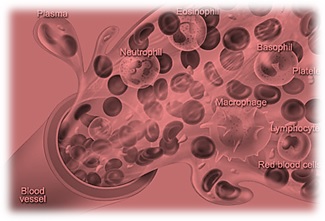Liquid connective tissue
Tissues that establish association between cells and organs of the body is termed as connective tissue.
Connective tissues are of different types depending upon the cells, their structure and their distance. Therefore, types of connective tissue are:
- Connective tissue proper
- supportive connective tissue
- fluid connective tissue
Liquid connective tissue also called fluid connective tissue are present in the form of liquid and hence helps in the circulation of important metabolites.
Liquid connective tissue can be basically classified into three different types:
1. Blood
- The volume of blood in adult with average age is 5litre.
- It is slightly basic with pH in between the range 7.35-7.45
- It contains plasma and different cells which are RBC, WBC and platelets.
Plasma:
- It constitute 55% of blood volume.
- Plasma is Straw yellow in color.
- Plasma have 92% water and 8% plasma protein.
- It is made by the combination of different chemicals named sodium, potassium, chloride and calcium. The amount of these chemical components vary where sodium makes up 135-145 mmol per liter and lowest is the calcium that ranges between 2.1- 2.8 mmol per liter.
- Plasma contains proteins, electrolytes, clotting factors, glucose, hormones and carbon dioxide.
- Plasma helps in circulation of amino acid, glucose and fatty acids.
- Plasma helps in removal of waste products
Cells
Blood contain three types of cells: RBC, WBC and platelets.

RBC:
- RBC occupies 45% of the blood.
- RBC also called erythrocytes contains hemoglobin.
- RBC are reddish in color.
- The shape of erythrocyte is biconcave which is maintained by the presence of cytoskeletal proteins.
- Flexibility in shape.
- RBC helps in distribution and exchange of oxygen.
WBC:
- WBC also called leukocytes helps in defense against microbes and harmful substances.
- WBC are present in less amount in comparison to erythrocytes which is 4000-10000per ml.
- They can be broadly divided into different types on the basis of their morphological character. This includes: Neutrophils, Eosinophil, Basophils, Monocytes and Lymphocytes.
- Neutrophils makes up 40-75% of WBC and gulp bacteria through phagocytosis.
- Lymphocytes makes up 20-40% of WBC. These are of two types called B-lymphocytes and T-lymphocytes. B- Cells have immunoglobulin on their surface and hence exert antigenic property whereas T- cells shows cell mediated immune response.
- Monocytes makes up 2-10% of WBC and shows several immunologic property. They have phagocytic effect, consume antigen and helps in their processing and presentation.
- Eosinophil makes up 1-6% of WBC and help by employing cytotoxic effect on bacteria.
- Basophils makes up less than 1% of WBC and shows phagocytic properties in combination with other cells.
- Moreover, WBC helps in exclusion of debris.
Platelets:
- Platelets also called thrombocytes helps in clotting of blood.
- The normal platelets ranges from 150000- 450000 per microliter of blood.
- Absence of nucleus in platelets.
- They are biconvex in structure.
- It helps in blood clotting by stomping the damaged blood vessels.
- Platelets also helps in homeostatic of the body.
Function of Blood:
- Blood helps in supply of nutrients and other materials to different tissues and organs.
- Blood helps in transport and exchange of oxygen and carbon dioxide in the body.
- Helps in detoxification of waste products.
- Provides defense against microbes and leucocytes.
- Regulates the pH in the body.
- It also helps in regulation of temperature.
- Blood haves the clotting property.
2. Lymph:
- It is same like that of blood but components and composition varies.
- Lymph contains WBC in higher amount.
- It consist of lymph nodes, lymph duct and lymph vessels that works in co-ordination.
- 1-2 liters of lymph is produced daily.
- Helps in defense mechanism.
- Helps in exchange of water and blood in the tissues of the body.
3. CFS:
- Also called cerebrospinal fluid is also a liquid connective tissue found in brain and spine.
- CFS contains 0.3% of plasma protein.
- CFS is present within the meninges.
- Low glucose concentration.
- Low content of protein and high content of chloride.
- Moreover, CFS helps in the protection of brain thus acts like a liquid helmet for the brain.
Experts help:
If you are worried about the assignment and projects on liquid connective tissue, get in touch with the tutor of www.assignmenthelp.net. Competent team of experts and advanced medium of delivering lecture will help you understand the topic well. Assignment though seems tough and time- consuming but once you make up your mind and rely on our tutors; they will handle your academic problem effectively making it easy for you to submit all your work on time. Our service is all time active with brilliant faculty and world- class facilities. So, get help with your projects, assignments, homework’s, report making, on liquid connective tissue with assignmenthelp.net at cheap and reasonable price.


